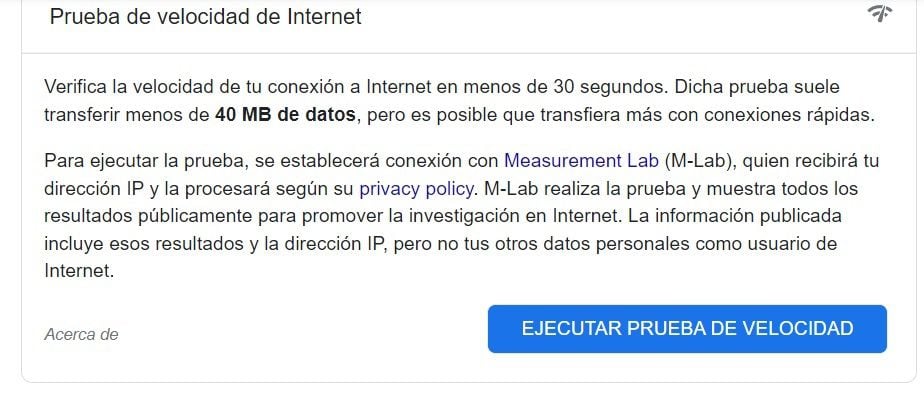

As is known, no matter how much an internet service is contracted with a certain speed, the truth is that it is a variable that is affected by different factors, including the number of connected devices.
So traffic, equipment, connection needs vary and often you want to know what real speed is counted at any given time. For that, Google offers a solution that is very easy to find. You just have to type the phrase “internet speed” in the browser and you will see that a box appears that says “Internet speed test” and a blue button with the caption “run speed test”. You must press there to know this information.

The legend explains that to run the test, a connection will be established with Measurement Lab (M-Lab), which will receive your IP address and process it according to its privacy policy. It is the entity mentioned that performs the test and displays the results. It is clarified that the information published includes the results obtained, as well as the IP address, but not other personal data.
On the other hand, there are many applications and sites that can be used to evaluate the speed of the connection at different times of the day. Some of the most popular services are Speedtest.net, Speedof.me or Fast.com, among others.
The tests carried out, which take less than a minute, will show the upload and download speed, as well as the ping, which is a latency parameter and measures how long it takes for the data to travel back and forth to the server being tested. In short, ping measures, in milliseconds, the time it takes for your local connection to a remote computer on the IP network to connect.
How to improve the connection
There are different strategies to consider to improve the signal:
Choose between 2.4 GHz and 5 GHz. The Wi-Fi of most routers operates on two bands: one 2.4 GHz and one 5 GHz. The 2.4 GHz has a longer wavelength, which gives it a longer range. Anyway, its speed is lower. On the other hand, the 5 GHz has less range, but offers greater speed. Considering, choose which one can be the best option according to the user's need.
Repeaters. What a repeater does is receive the signal from the router and forward it, which helps it reach some areas of the home or office more intensely (from one floor to another, for example), but with a lower quality than what would happen if we were close to the router.
Mesh Wi-Fi. Mesh Wi-Fi, on the other hand, is composed of a router or main station and one or more satellites that connect to each other to improve network coverage. The wifi mesh system does an intelligent management in this regard: it is able to connect devices to the best option they have at that time. Unlike this, repeaters do not communicate with each other but only communicate with the router.
In the case of mesh Wi-Fi networks, advanced network management allows for better resource optimization and, consequently, better results. The same Wi-Fi network, SSID and password are maintained on a satellite system that feed back to each other so that the best possible signal is available depending on the time and place.
KEEP READING